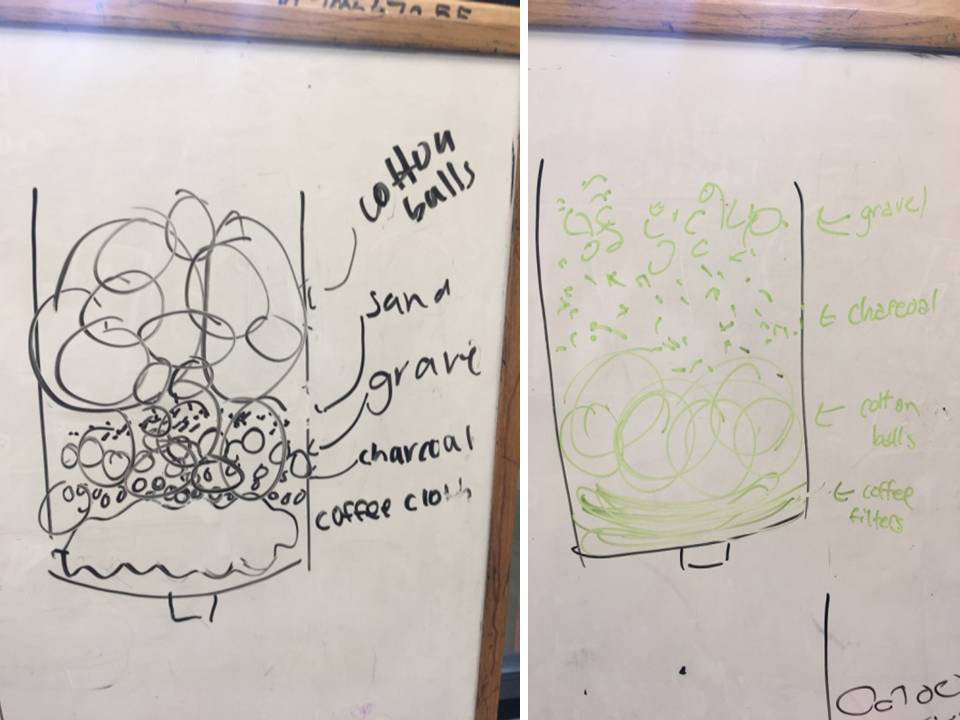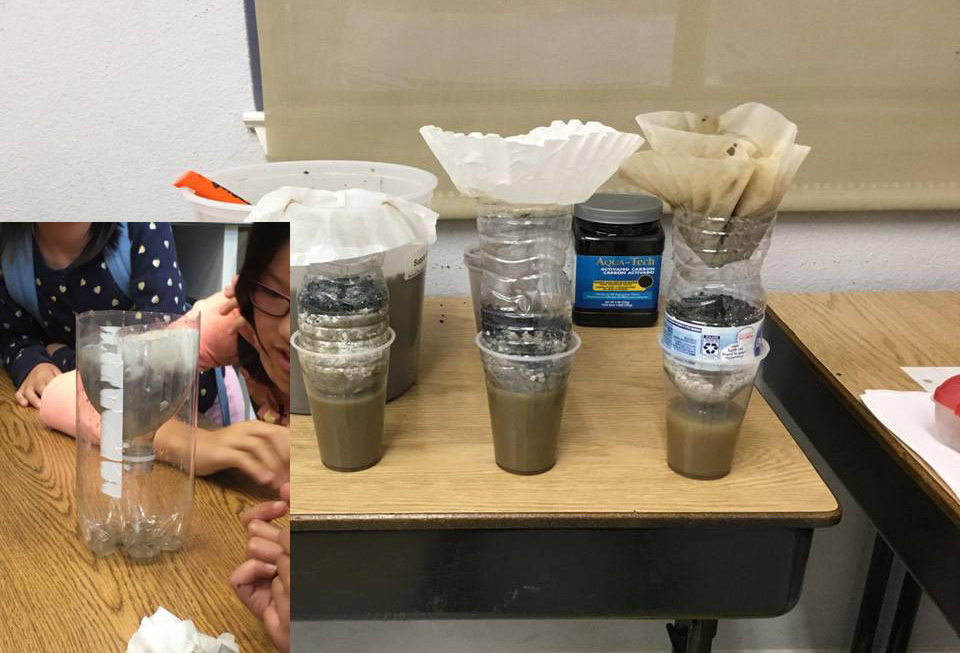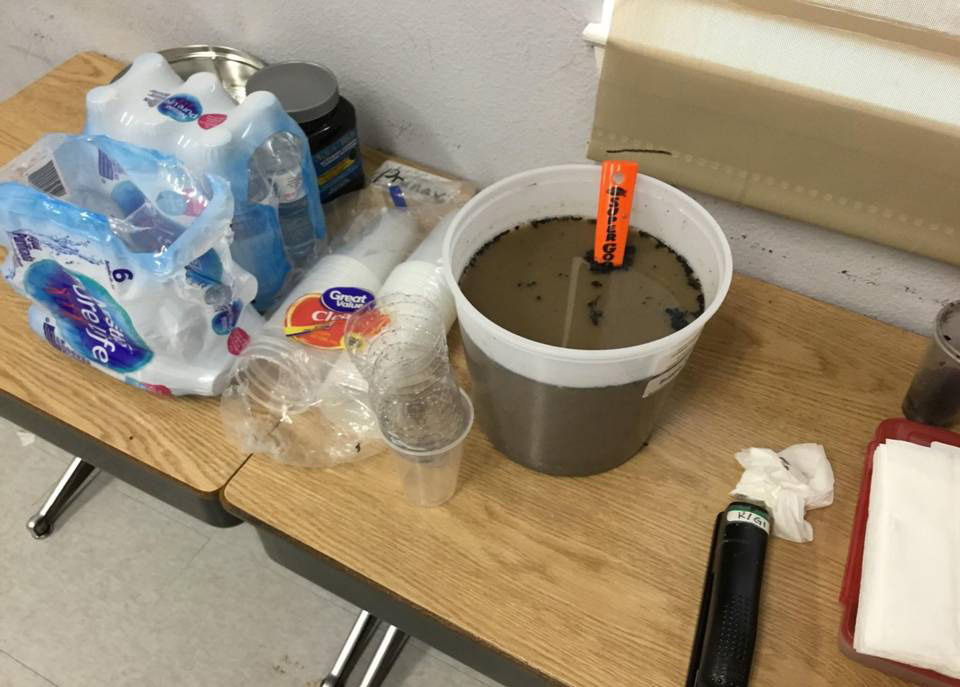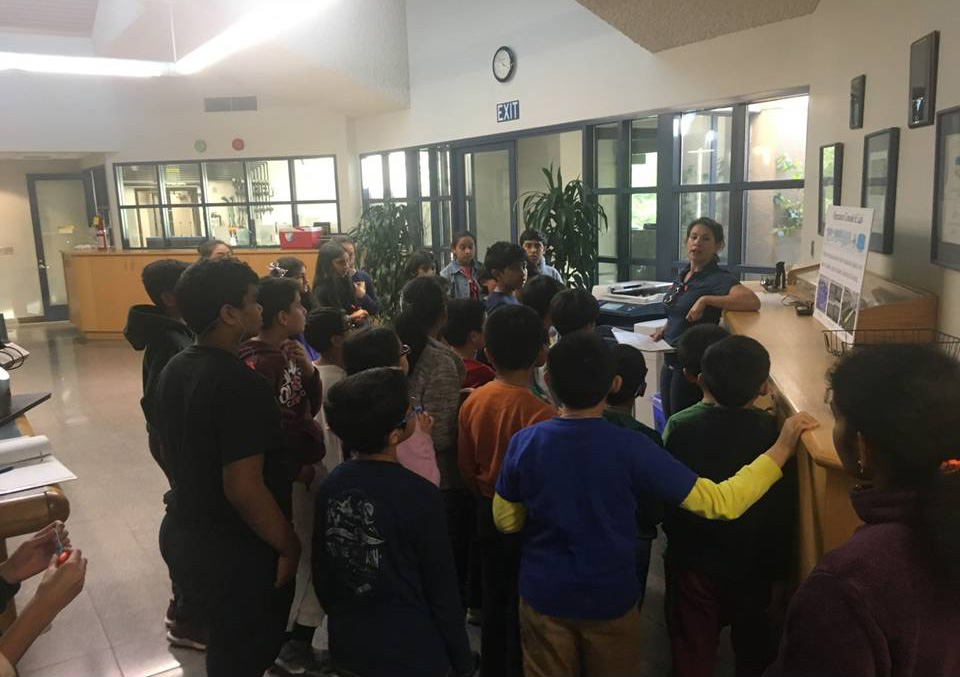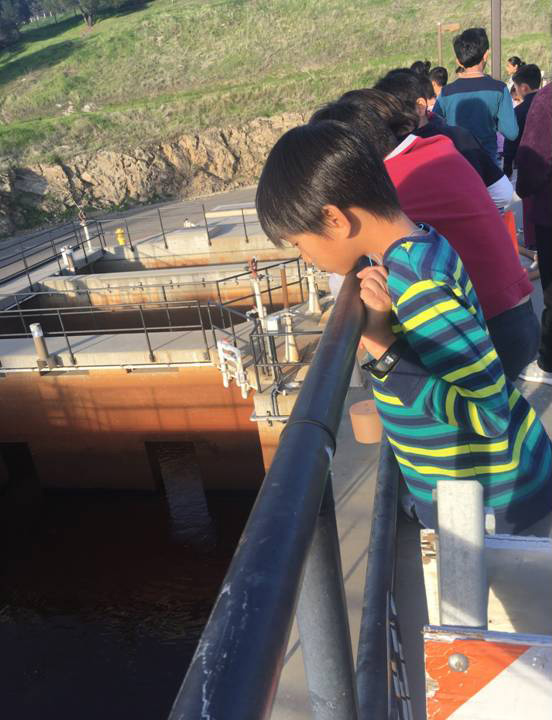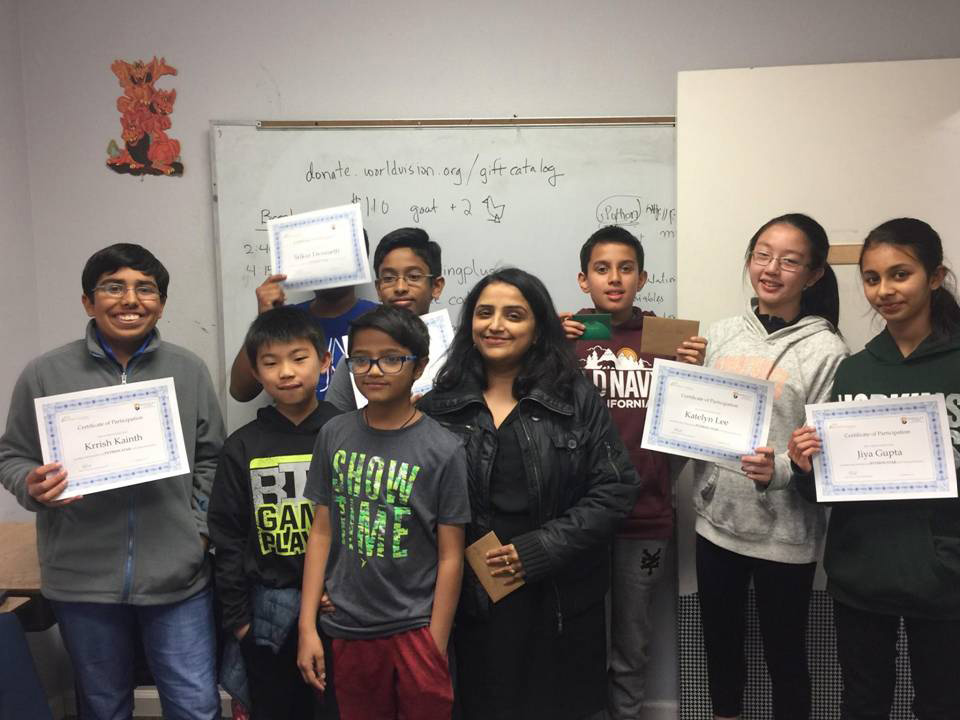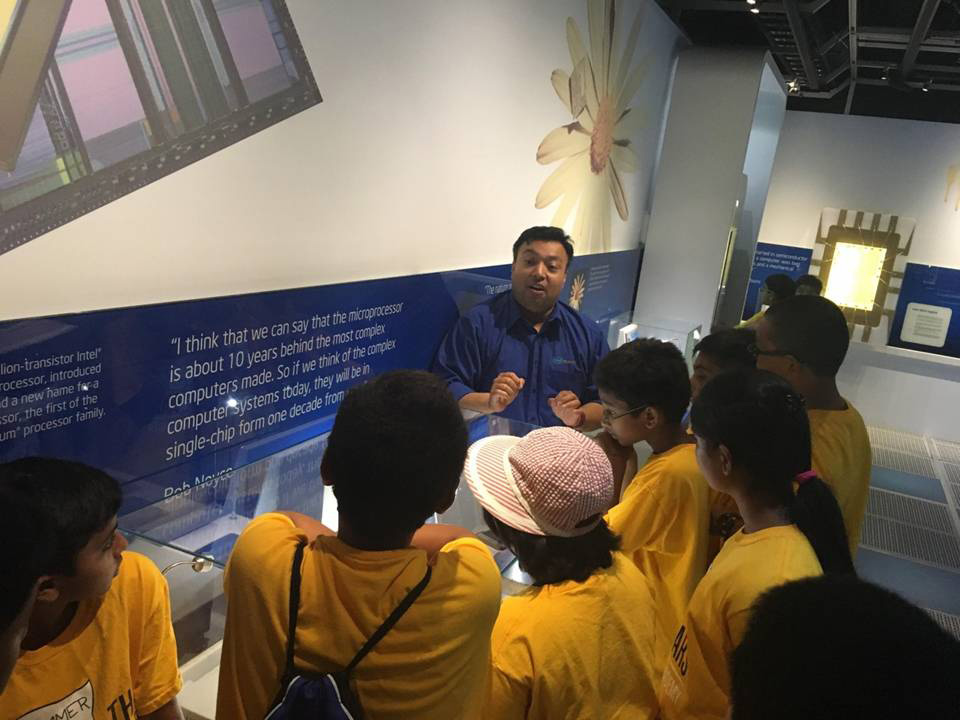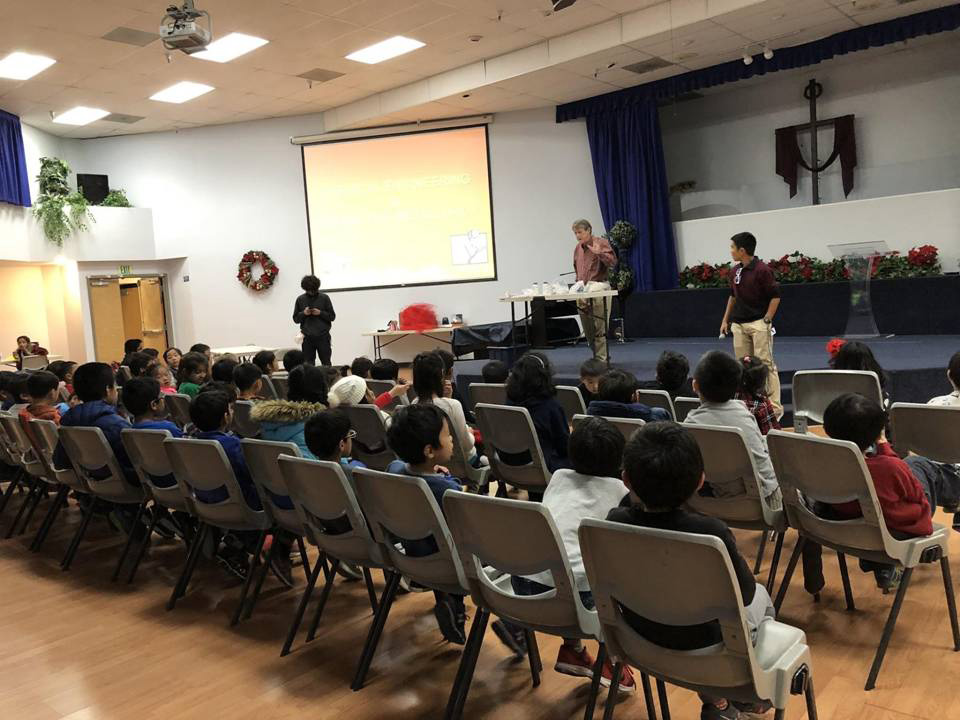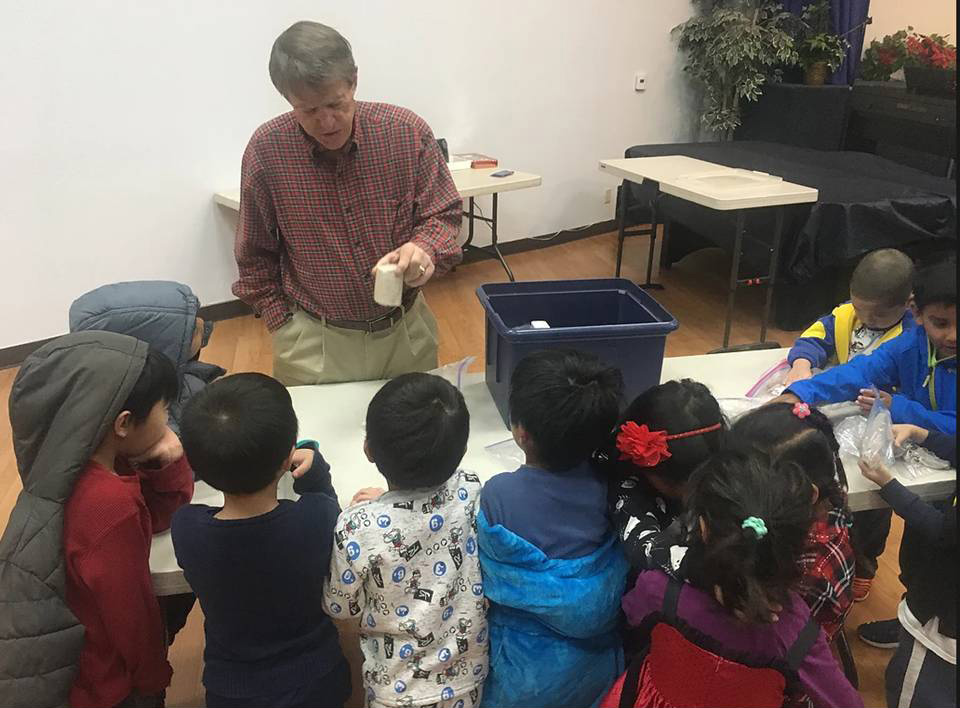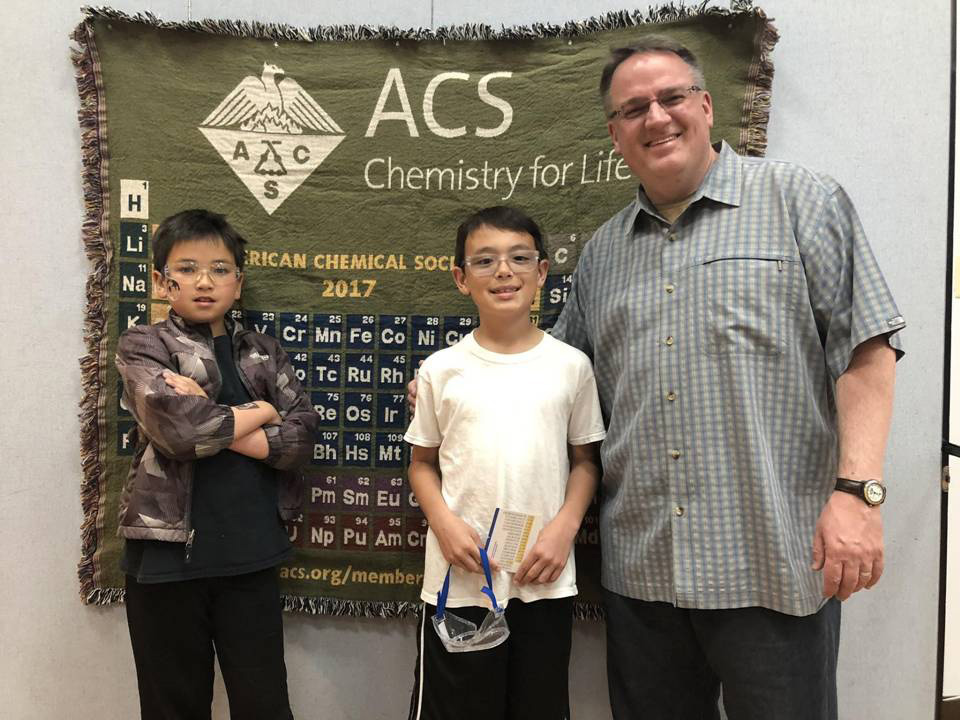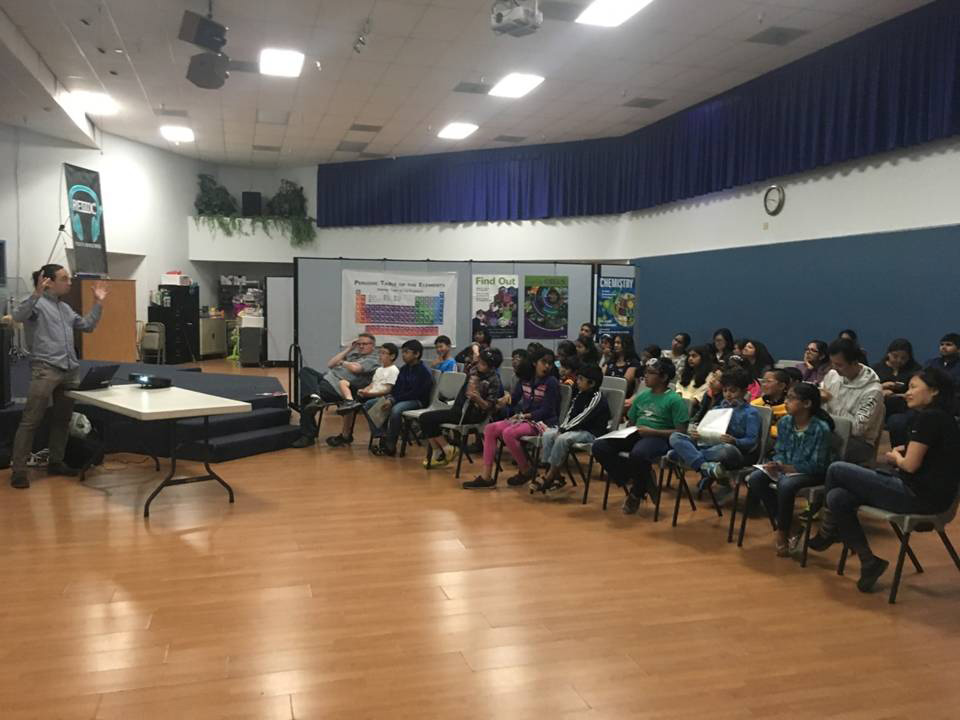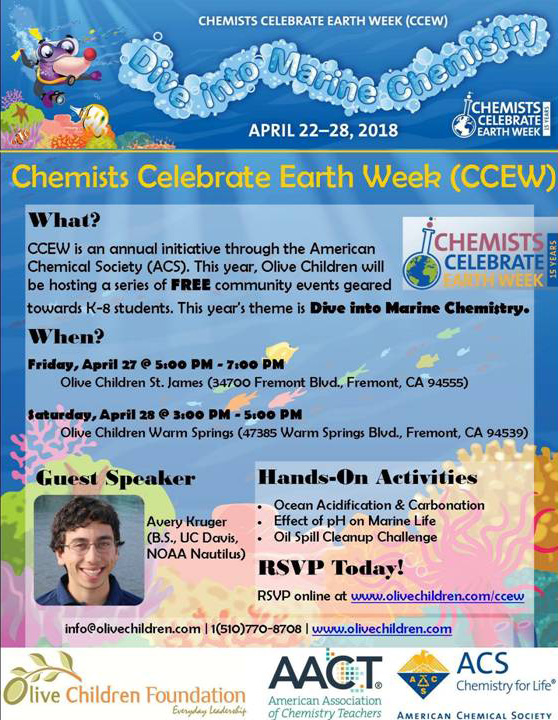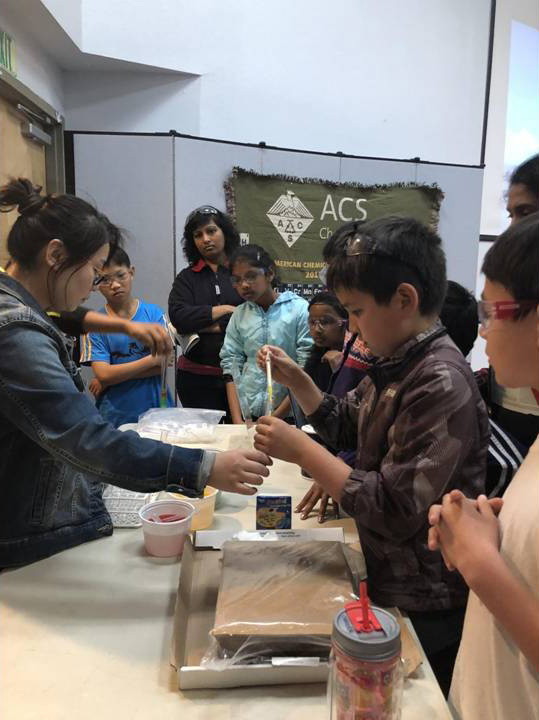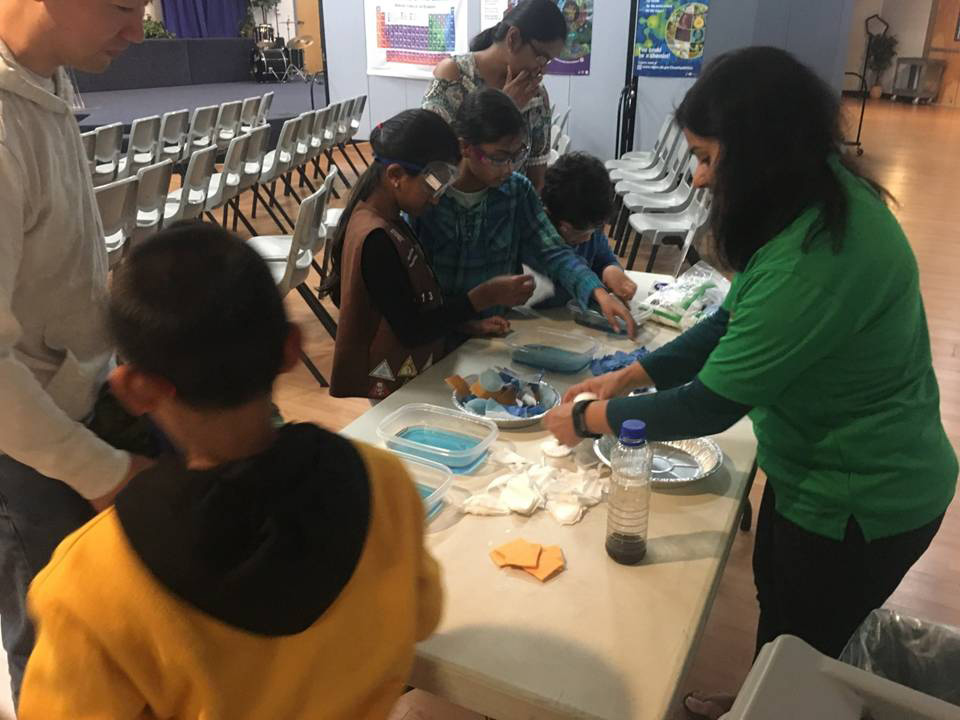The Engaged Scientist
Emerging Connections
Resourceful and Effective Ways of Bridging Afterschool STEM Programs and Local Community
Connected Science Learning October-December 2018 (Volume 1, Issue 8)
By Edward Njoo, Surabhi Narain, Lakshmidevi Pabbisetty, and Mahesh Agrawal
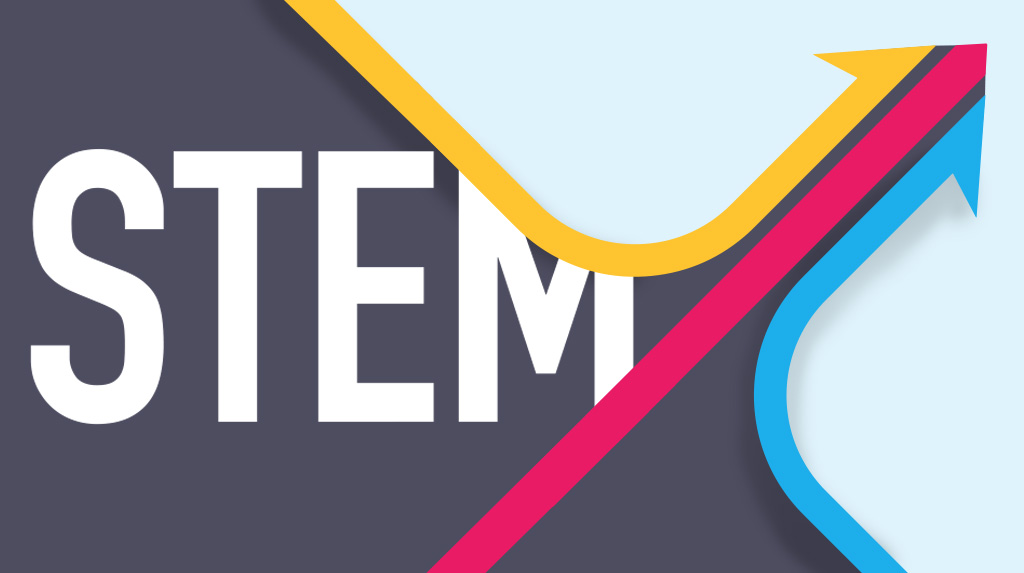
Learn about an effective and affordable three-focus approach that brings together academia, the community, and the real world in a way that makes afterschool STEM enrichment available to a wide audience.
Many have previously demonstrated the importance of afterschool programs in reinforcing academic success. A carefully planned afterschool program engaging students in STEM (science, technology, engineering, mathematics) activities demonstrably improves learning outcomes (Eccles and Templeton 2002). Dabney et al. (2012) and Sahin (2013) demonstrated that students who are exposed to STEM education in their elementary and middle school years are more likely to pursue STEM-related postsecondary education. As such, there has been a significant growth in focus on STEM in the afterschool setting.
Hands-on learning is a highly effective method of solidifying concepts learned in school. Early exposure to STEM-related hands-on learning opportunities can have a lifelong positive impact on students’ educational, personal, and professional pursuits. A previously conducted study, in which middle school students were enrolled in an inquiry-based, hands-on science program known as the Summer Science Exploration Program, showed that these students expressed greater interest and passion toward science and related careers (Gibson and Chase 2002). Students who are exposed to STEM hands-on learning not only show an increased passion for science but also have improved problem-solving skills (Paris, Yambor, and Packard 1998).
Partnering with community organizations—such as automobile factories, museums, science centers, and tech companies—is an inexpensive, highly feasible method of allowing students to fully understand STEM applications. Such partnerships are a great way for community members to get involved with local schools and inspire students, as well as provide mentorship, knowledge, and information about potential career opportunities. Learning about science outside of the classroom is also a highly effective method for explaining to students many challenging STEM concepts learned in class and demonstrating real-world applications. For example, Jarvis and Pell (2005) show that after visiting the UK National Space Centre, students aged 10 and 11 immediately reported an increased interest in and enthusiasm for space and an increased desire to become scientists in the future.
Despite the profound benefits of introducing STEM to students at an early age, there are several challenges in doing so. Access to STEM education programs in the afterschool setting has been largely limited economically. Individuals from underrepresented demographic and socioeconomic backgrounds tend to have fewer opportunities for STEM education compared to more affluent peers. Another major challenge faced by afterschool STEM programs is a lack of affiliation and collaboration with local museums, industries, and academic institutions. Strong partnerships with such institutions not only foster curiosity and interest among students, but also allow for more integrative education while promoting real-life, relevant applications of STEM.
Further, as we describe in this article, such partnerships significantly drive down cost barriers to running quality STEM programs in afterschool settings, which in turn improves program accessibility for students from families who lack financial means to pursue STEM education. We provide a sample scaffold of “STEM on a Dime,” an affordable and accessible approach to afterschool STEM programs that stimulates and engages young minds to delve deeper into the world of STEM through strong connections with local community partners.
Olive Children Foundation’s afterschool STEM program employs a multifaceted approach to enhancing the effectiveness of STEM programs at an affordable price. This approach can be used as a model for other afterschool programs seeking to promote and expand accessibility to STEM to include a wider range of students from more diverse demographic and socioeconomic backgrounds. The three-focus approach created and adopted by Olive Children Foundation incorporates hands-on learning, real-world application, and community involvement.
Through strong afterschool partnerships with local STEM organizations and hands-on learning opportunities outside of the classroom, Olive Children Foundation provides students with a wonderful opportunity to gain exposure to and appreciation for STEM in various diverse settings. Interacting with STEM professionals, applying knowledge through hands-on activities, and learning from real-world applications of STEM serve as a gateway for students to pursue their interests in STEM and delve deeper into the field.
A three-focus approach
At Olive Children Foundation, we have developed a three-focus approach to connect the afterschool STEM learning setting with the local community. The first aspect that we pioneered was coupling a robust afterschool hands-on curriculum with local industries, organizations, and agencies. For the second focus, we invited guest speakers from the community to share their expertise and experience with students in the afterschool setting, as part of our “Snacks With a Scientist” series. Finally, we collaborated with national organizations and academic societies to connect STEM disciplines with students in the community. Each of these three foci aims to build connections between in-school learning and out-of-school experiences.
Building community relationships between local industries, community members, and chapters of professional organizations takes a considerable amount of time and a variety of means. Finding a few contacts often leads to more connections; for example, several of the community partners that volunteered guest speakers or community helpers at Olive Children heard about the program through another, existing contact. These volunteers included parents, friends of staff members, local retirees, and representatives of local higher-education institutions.
Focus 1: Harnessing local industries, organizations, and agencies
The original and primary goal of the afterschool STEM programs at Olive Children Foundation was to involve students in hands-on activities that encourage inquiry-based learning, develop scientific and analytical skills, and parallel and reinforce the Next Generation Science Standards (NGSS Lead States 2013). Each month, activities centered around a particular theme, and students spent weekly sessions thinking through, learning about, and performing a hands-on activity related to the monthly theme. For example, one month focused on the natural ecology of the local Fremont/East Bay habitats. Students began the month by brainstorming various facets of the ecology of the East Bay region and with a webquest of the indigenous flora and fauna of the San Francisco Bay Area region. Later in the month, students took a field trip to Dawson Pond on campus at a local community college to catalogue various forms of wildlife and to analyze effects of local human activity.
Many educators find it challenging to connect STEM in the classroom to STEM in the real world. This is, however, arguably one of the more important aspects of early STEM education. Through partnerships with local companies, government agencies, and organizations, students in our afterschool STEM programs were able to see science in action. Field trips were incorporated into several of the monthly themes to help connect classroom learning with local industry.
Example 1
A particularly successful partnership integrated the afterschool STEM program with a local government agency, the ACWD (Alameda County Water District), for a unit on mixtures and solutions. This concept was taught through a preliminary hands-on activity and an afterschool field trip to the ACWD water treatment facility.
During the hands-on activity (see Figure 1), students were challenged to work in groups to design a water filter that could purify “contaminated” water containing dirt, sediment, pebbles, leaves/plant material, and twigs. Students had access to a variety of materials, such as large cotton balls, sand, gravel, coffee filters, and activated charcoal, to design their filters. Once the designs were complete, students tested them to see which setup worked best. Students discovered that certain materials, such as coffee filters and cotton balls, were not as effective in purifying the water, whereas combinations of other materials worked better (see Figures 2 and 3).
Figure 2
Student-designed water filtration systems on display after a lesson on water purification. Inset: A student watches as her group’s filter removes impurities from the water.
Figure 3
The “contaminated” water was created by dissolving fine potting soil in tap water. Students were challenged with the task of engineering an effective and economical water filtration process.
The week after the activity, students visited the water treatment facility in Fremont, California (see Figures 4 and 5). During the tour of the facility, students learned about the water treatment process and saw the equipment and process in action. Students were very curious and excited by the trip because it was a great way to connect science to something that has direct impacts on their lives. Further, the water purification activity performed before the visit helped set the stage for the relevance of clean-water chemistry, which students would learn about during their tour of the ACWD water treatment plant.
Figure 4
Students on an afterschool field trip to the Fremont ACWD water treatment plant listen to a specialist explain the water purification process.
Figure 5
A student peers into a large vat used in the sedimentation of particulates out of water, one step of the ACWD water treatment process.
The water purification activity described addresses NGSS engineering learning objectives and disciplinary core ideas, as students “define a simple design problem that can be solved through the development of an object, tool, process, or system and includes several criteria for success and constraints on materials, time, or cost” (NGSS Lead States 2013, 3-5-ETS1-1).
The curriculum and corresponding engagement with ACWD was put together at a negligible cost. Materials for the hands-on activity (e.g., bottles, dirty water, turbidity meters, materials for filters) were purchased for <$50 for a class of 24 students. There was no cost for the tour of the ACWD facility. We found that most local government and private industries, such as the ACWD facility, were quite willing to aid in local science education endeavors. This is a translatable model for educators across all communities, because public agencies and industries are generally ubiquitous. However, because some agencies do not have existing science education programs, finding contacts who are willing to accommodate student groups is a rather time-consuming process.
Student responses following the field trip were generally positive: 64% of student participants indicated that the experience broadened their view of STEM’s applications in everyday life, and 95% of student participants indicated that they learned something new about the application of science and engineering to an often-overlooked process.
Example 2
Olive Children’s afterschool STEM program includes a makerspace to foster hands-on learning and problem-based creativity through various maker activities. Loosely defined, the Maker Movement was designed to foster and promote creativity and innovation through tinkering and hands-on, exploration. In Olive Children’s afterschool makerspace, students are provided with everyday materials and a curriculum that challenges them to think outside of the box and use their creativity to engineer solutions to real-world issues. We also found a novel use for the makerspace in conjunction with local technology and engineering companies in Silicon Valley.
In one activity, which we called the Bobsled Challenge, students were able to take a hands-on approach to learning about forces, energy, and the interconversion of various forms of energy. This activity is in alignment with NGSS physical science standards: “Apply scientific ideas to design, test, and refine a device that converts energy from one form to another” (NGSS Lead States 2013, 4-PS3-4). Using their understanding of these concepts, students worked in groups to design and build their own bobsleds out of index cards, plastic cups, and tape (see Figure 8). Students used their innovating skills to modify a simple sled model to make it more efficient and reduce friction. To test their sleds, a makeshift racecourse was set up, and students participated in an exciting competition to see which group’s design strategy worked best (see Figure 9). By the end of the activity, students had a better understanding of how forces and energy are related and of the many practical applications of these concepts. As with the first activity, this hands-on application proved highly cost-effective. The material cost for the Bobsled Challenge was less than $15 for a class of 24 students (e.g., index cards, plastic cups).
This activity was performed in alignment with NGSS standard 3-5-ETS1-1: “Define a simple design problem reflecting a need or a want that includes specified criteria for success and constraints on materials, time, or cost” (NGSS Lead States 2013). Here, students used everyday materials to design and construct a bobsled with the best possible efficiency in converting potential energy to kinetic energy.
Following this investigation, we invited local community members who currently work in Silicon Valley to share their expertise in computer science, mechanical engineering, and electrical engineering in conjunction with the makerspace activities. For example, a materials engineer, who had decades of industry experience designing transportation-related synthetic materials, was invited to share his experiences with students.
Focus 2: Bridging Community Members and Afterschool
Local communities can be a source of hidden treasures—stories, resources, and people that can drive local STEM learning in a way that brings students together with organizations and individuals in the community. The local talent in the community was harnessed by engaging and integrating community volunteers with industrial or academic experience in various STEM fields with afterschool K–8 programs built around monthly themes.
For example, one monthlong focus on engineering incorporated introductory computer science and programming, wherein a cohort of junior high students successfully completed an introductory Python coding course (see Figure 6). The course was led by Meenal Pant, a parent volunteer and community member who works in the computer science industry, to share with students her expertise in computer programming. Being at the heart of Silicon Valley, the afterschool program at Olive Children also made use of local corporations, including Intel and Cisco, in developing students’ appreciation for computer science and computer engineering. Students toured the Intel Museum and Computer History Museum, just minutes away from several of our afterschool centers, in conjunction with learning computer science in afterschool enrichment programs (see Figure 7).
Figure 6
Mrs. Pant, a parent and community volunteer, stands with her middle school students who successfully completed an introductory Python course.
Figure 7
A docent at the Intel Museum leads students through an exhibit about the advent of microprocessors.
Earlier this school year, we launched a guest speaker series, Snacks With a Scientist, to function as a capstone to each monthlong theme. Each month, a community member with an academic or industrial background in a STEM-related field was invited as a guest speaker to share their experiences with regular attendees of the afterschool program. To conclude a monthlong study of rocks and minerals, for example, we invited a retired chemical process engineer who had spent several decades managing ore-mining operations throughout the West Coast. During these Snacks With a Scientist events, the designated guest speaker would give a 15- to 20-minute presentation on his or her area of expertise, and how it ties in to what students have learned all month. A 15- to 20-minute question-and-answer session followed. Many guest speakers bring in artifacts, samples, and other props so students can gain a tangible appreciation for the scientist’s area of expertise. By hearing from community professionals, students had the opportunity to explore a wide range of STEM careers, including marine biology, engineering, veterinary science, and chemical engineering (see Figures 8 and 9).
Figure 8
Andy Sass, a former chemical engineer from the local community, was one of the guest speakers invited to share his experiences with afterschool students in the “Snacks With a Scientist” guest speaker series hosted by Olive Children Foundation.
Figure 9
Sass shows samples of minerals containing sodium bicarbonate from his work in mining and extraction to a group of curious students.
Students gained a much broader view of possible STEM career paths after participating in the Snacks With a Scientist guest speaker series. Following the series, an overwhelming majority (78%) of students who are part of our afterschool program stated that they explored a field they were previously unfamiliar with and, on average, over 80% of students were more interested in the guest speaker’s field of expertise after hearing the presentation. Fifty-eight percent of students stated that their interest in pursuing a career in STEM fields was positively impacted by the guest speaker presentations. All guest speakers featured in this year’s speaker series stated that they felt more connected to the youth in the community, and that they thought that giving talks to students in the afterschool context was a worthwhile pursuit.
Focus 3: Partnering with national organizations
This year, Olive Children also ran an event in conjunction with the American Chemical Society (ACS) called Chemists Celebrate Earth Week (CCEW; see Figures 10–12). This year’s theme was “Dive Into Marine Chemistry.” We invited Avery Kruger, a local community member, to share his expertise in marine ecology and research experience aboard the National Oceanic and Atmospheric Administration’s research vessel, the E/V Nautilus (see Figures 10 and 11). Additionally, students and parents participated in a series of hands-on activities illustrating different aspects of marine chemistry, including a salt water density rainbow, wherein students use different concentrations of salt water at different densities to create a colorful “rainbow” in a test tube (Figure 13). Another activity engaged students in the issue of ocean acidification as participants studied the effects of ocean carbonation (represented by tonic water or club soda) on calcium carbonate seashells. Finally, the third activity involved an “oil spill cleanup” wherein participants surveyed the relative efficacy of different sorbent materials in removing an “oil spill” from the surrounding water (Figure 14).
Figure 10
Students and a parent pose in front of a periodic table tapestry during the CCEW event, run in conjunction with ACS.
Figure 11
Guest speaker Avery Kruger, a local marine biologist and oceanographer, delivers a talk about life under the sea as part of the CCEW event.
Figure 12
Flyer used to promote the CCEW event run in conjunction between Olive Children Foundation’s afterschool STEM programs and ACS.
Figure 13
A community volunteer demonstrates how to create a salt water rainbow using different-colored solutions of salt water of various concentrations with different densities.
Figure 14
A staff member demonstrates how different sorbent materials can be used to clean an oil spill as part of the CCEW event.
These and other materials were provided by ACS, and a link for online resources, including student activities and instructions, are available at the end of this article. Each activity illustrated the NGSS’s disciplinary core ideas through hands-on learning. For example, at the oil spill clean-up station, students learned about human impacts on the environment and potential solutions to clean up an oil spill that poses a risk to the health of several ecological communities: “Make a claim about the merit of a solution to a problem caused when the environment changes and the types of plants and animals that live there may change” (NGSS Lead States 2013, 3-LS4-4). Additionally, Mr. Kruger’s lecture, which focused on adaptation and diversity in deep-sea ecosystems, was aligned with NGSS life science learning objectives: “Construct an argument with evidence that in a particular habitat, some organisms can survive well, some survive less well, and some cannot survive at all” (NGSS Lead States 2013, 3-LS4-3).
Volunteers came from the local community and consisted of parents, college students, and older high school students in 11th or 12th grade who had adequate background in the sciences. For example, several of our volunteers were recent graduates of the chemistry program at San Jose State University. Two weeks prior to the event, the materials for the activity were distributed electronically to the volunteers, and training was conducted in an hour-long session held the week before the event. Volunteers were familiarized with each station’s activities, safety considerations, and tips for working with students. Prior to the start of the event, volunteers participated in a 30-minute meeting to help them get situated for the event.
Feedback regarding the execution and outcomes of the event from the California Section of ACS was very positive, and students and parents alike enjoyed the interaction between professional and academic societies and the afterschool programs. Almost all parents surveyed afterward indicated that events such as this gave them an increased awareness of professional societies and their role in science outreach. Only 5% of parent attendees indicated that they had previously known about ACS, and nearly all of them left the event with a clearer sense of the importance of professional societies in public education. Eighty-eight percent of student attendees indicated that they learned something new about ocean chemistry through the event. In this particular example, ACS provided the content and branding materials, while the afterschool staff brought these ideas to life by implementing events such as CCEW in our immediate community.
Conclusion
Afterschool STEM education programs can have a significant and widespread impact on the intellectual development of young children. To make such programs accessible and affordable, we have developed an efficient, three-focus model for developing curricula for STEM programs that makes use of partnerships between local companies and sponsors.
This translatable approach seeks to overcome economic barriers by making use of local resources. By using this model, afterschool programs can provide effective and enriching experiences for students of all ages and interests, while maintaining a commitment to cost-effective modes of teaching science, technology, engineering, and math.
Edward Njoo (edward.njoo@olivechildren.com) is STEAM director and lead science instructor at Olive Children Foundation in Fremont, California. Surabhi Narain (Surabhi.narain@olivechildren.com) is a STEM instructor at Olive Children Foundation in Fremont, California. Lakshmidevi Pabbisetty (Lakshmi.p@olivechildren.com) is a STEM instructor at Olive Children Foundation in Fremont, California. Mahesh Agrawal (Mahesh.agrawal@olivechildren.com) is a STEM instructor at Olive Children Foundation in Fremont, California.
Interdisciplinary STEM Informal Education



